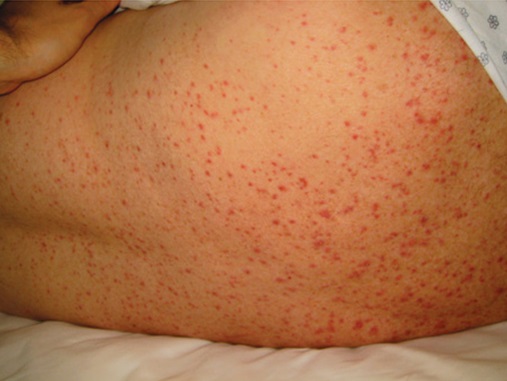Introduction
Heat stroke is define as a life-threatening illness characterized by an elevated core body temperature that rises above 40° C and central nervous system dysfunction that results in delirium, convulsion or coma. Heat stroke is often fatal if left untreated. Heat stroke is a severe form of heat related illness. Heat related illness comprise a range of disorders from minor to major as shown in table 1.
| Severity | Types | definition |
| Minor | Heat edema | is a self-limited process manifested by mild swelling of the feet, ankles, and hands that appears within the first few days of exposure to a hot environment. |
| Prickly heat | is a pruritic, maculopapular, erythematous rash over normally clothed areas of the body (figure 1). | |
| Heat cramps | are painful, involuntary and spasmodic contractions of skeletal muscles | |
| Heat syncope | Is a variant of postural hypotension (low blood pressure) resulting from the cumulative effect of relative body water depletion, peripheral vasodilatation, and decreased vasomotor tone that lead to syncope. | |
| Heat exhaustion | Is occur because of body water and/or sodium depletion that tends to occur in the elderly and in persons working in hot environments with inadequate water replacement which subsequently lead to lethargy and dizziness | |
| Major | Heat stroke | Is a life-threatening illness characterized by an elevated core body temperature that rises above 40° C and central nervous system dysfunction that results in delirium, convulsion or coma. |
Table 1: severity of heat related illness from mild illness to major illness.

Figure 1: pruritic, maculopapular, erythematous rash
Signs And Symptoms
Signs and symptoms of heat stroke is an accumulation symptoms of heat related illness with nervous system abnormalities as shown in table 2
| Heat related illness | Heat Cramp | Heat Exhaustion | Heat Stroke |
| Signs and symptoms |
|
|
|
Causes
Mechanism of heat stroke is due to an absence of heat-dissipating mechanisms such as radiation (transfer of heat by electromagnetic waves from a warmer object to a colder object), conduction (heat exchange between two surfaces in direct contact), convection (heat transfer by air or liquid moving across the surface of an object) and evaporation (heat loss by vaporization of sweat). Heat is also accumulated through radiation from the sun and direct contact with hot objects, and is absorbed when the environment temperature rises above body temperature. There are several risk factors such as:
- High environmental heat stress (hot weather)
- Individuals who are physically fit and participating in athletic events
- Performing jobs under conditions of high heat stress, such as firefighting or military training.
- Physical exercise
- Children are left inside hot cars
Treatment
- First aid
- remove patient from heat exposure
- rest in a cool environment
- perform immediate cooling
- remove clothing
- spraying the patient with cool water
- allowing airflow over the patient using a fan
- placing wet towels or sheets over the patient’s body
- placing ice packs over the neck, groin, and axillae
- Immediately call 999 to get help for ambulance and paramedic.
- In hospital
- Initial resuscitation with intravenous fluid should be initiated at a rate that ensures adequate urine output, beginning with 250 mL/h normal saline solution. For peadiatric <25kg, use body weight to determine fluid resuscitation per hour (10 cc/kg) to avoid over hydrated.
- Monitoring of core temperature using an electronic rectal thermometer, temperature probe–equipped urinary drainage catheter, or esophageal thermometer is essential.
- Patient will be cooling by physical method to reduce the core temperature to 39°C and then stop to avoid overshoot hypothermia.
- Aspirin and paracetamol have no role in the treatment of patients with heat stroke and may be worsen patient condition.
Complication
- Early complication
- Hypotension (low blood pressure)
- Hypothermic overshoot due to overcooling
- Hyperthermic rebound
- Rhabdomyolysis
- Altered mental state
- Seizures
- Heart failure and Pulmonary edema
- Hypokalemia
- Hypo/hypernatremia
- Late complication
- Cerebral edema
- Encephalopathy
- Persistent neurologic deficit
- Myocardial injury
- Acute respiratory distress syndrome
- Renal failure
- Intestinal ischemia or infarction
- Pancreatic injury
- Liver dysfunction
- Hypocalcemia, hyperkalemia and hyperuricemia
- Thrombocytopenia and disseminated intravascular coagulopathy.
References
- Tintinalli, J. E. (2013), Emergency Medicine manual 7th edition
- Bouchama, A., & Knochel, J. P. (2002). Heat stroke. New England Journal of Medicine, 346(25), 1978-1988.
- Shibolet, S., Lancaster, M. C., & Danon, Y. (1976). Heat stroke: a review.Aviation, space, and environmental medicine, 47(3), 280-301.
| Last Reviewed | : | 23 August 2019 |
| Writer | : | Dr. Ahmad Jaihan b. Ismail |
| Accreditor | : | Dr. Mohd Lotfi b. Hamzah |
| Reviewer | : | Dr. Mohamad Hamim b. Mohamad Hanifah |







